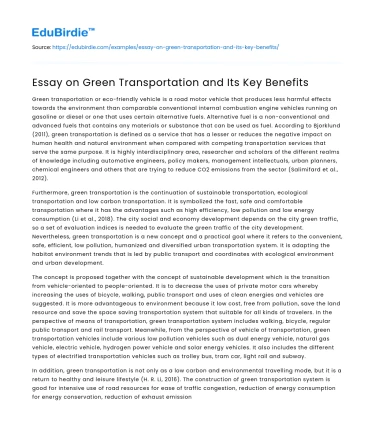Green transportation or eco-friendly vehicle is a road motor vehicle that produces less harmful effects towards the environment than comparable conventional internal combustion engine vehicles running on gasoline or diesel or one that uses certain alternative fuels. Alternative fuel is a non-conventional and advanced fuels that contains any materials or substance that can be used as fuel. According to Bjorklund (2011), green transportation is defined as a service that has a lesser or reduces the negative impact on human health and natural environment when compared with competing transportation services that serve the same purpose. It is highly interdisciplinary area, researcher and scholars of the different realms of knowledge including automotive engineers, policy makers, management intellectuals, urban planners, chemical engineers and others that are trying to reduce CO2 emissions from the sector (Salimifard et al., 2012).
Furthermore, green transportation is the continuation of sustainable transportation, ecological transportation and low carbon transportation. It is symbolized the fast, safe and comfortable transportation where it has the advantages such as high efficiency, low pollution and low energy consumption (Li et al., 2018). The city social and economy development depends on the city green traffic, so a set of evaluation indices is needed to evaluate the green traffic of the city development. Nevertheless, green transportation is a new concept and a practical goal where it refers to the convenient, safe, efficient, low pollution, humanized and diversified urban transportation system. It is adapting the habitat environment trends that is led by public transport and coordinates with ecological environment and urban development.
Save your time!
We can take care of your essay
- Proper editing and formatting
- Free revision, title page, and bibliography
- Flexible prices and money-back guarantee
The concept is proposed together with the concept of sustainable development which is the transition from vehicle-oriented to people-oriented. It is to decrease the uses of private motor cars whereby increasing the uses of bicycle, walking, public transport and uses of clean energies and vehicles are suggested. It is more advantageous to environment because it low cost, free from pollution, save the land resource and save the space saving transportation system that suitable for all kinds of travelers. In the perspective of means of transportation, green transportation system includes walking, bicycle, regular public transport and rail transport. Meanwhile, from the perspective of vehicle of transportation, green transportation vehicles include various low pollution vehicles such as dual energy vehicle, natural gas vehicle, electric vehicle, hydrogen power vehicle and solar energy vehicles. It also includes the different types of electrified transportation vehicles such as trolley bus, tram car, light rail and subway.
In addition, green transportation is not only as a low carbon and environmental travelling mode, but it is a return to healthy and leisure lifestyle (H. R. Li, 2016). The construction of green transportation system is good for intensive use of road resources for ease of traffic congestion, reduction of energy consumption for energy conservation, reduction of exhaust emission for improvement of air quality, the reduction of carbon emission to decrease the greenhouse effect, and construction of livable cities for improvement of citizen health. Thus, the development of urban green transportation is an important measure for saving energy as it can reduce carbon and PM2.5 emission and improving environment (Cao et al., 2015).
On the other hands, there are few characteristics of the green transportation that can increase the attention and attraction towards the user. Perceived characteristics of an innovation that affects the rate of adoption is relative advantages that consists of over existing products in term of perceived economic benefit, convenience, satisfaction and status giving (Lane & Potter, 2007). The simple and convenience of the green transportation where the consumers are only likely to adopt products designed for ease and convenience of use. Besides, fuel economy or cost where green transportation refer to the economy of driving and lower fuel bills (Ozaki & Sevastyanova, 2011). Meanwhile, the green transportation became user’s preference to owning the car and it describes the user’s acceptance is measured by their subjective habits and objective reasoned appraisal.
Therefore, green transportation is very advantageous to the environment because it is really convenient and healthy. To improve the better life for future generation, green transportation really needs to be developing and implement so that people can be attracted to this kind of alternative transportation.






 Stuck on your essay?
Stuck on your essay?

